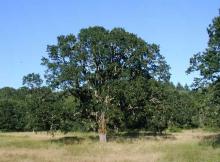
Image Credit: oregonstate.edu
Family: Fagaceae
Common names: Oregon white oak, garry oak
General bloom time: April - June
Identification: Deciduous tree up to 25m tall. Bark is gray with deep furrows and scales.
Leaves: alternate, up to 12cm long. Leaf blades are oblong and have deep round lobes. Leaf blades are dark, shiny green on top with a lighter shade of green on the bottom with a leathery texture.
Flowers: Separate male and female flowers. Flowers are tiny, male flowers in catkins that hang down, female flowers single or in clusters.
Fruit: Acorn with a shallow cap, 2 to 3 cm long. They are edible.
Habitat: Dry prairies or rocky areas at low elevations. Intolerant of shade.
Ecology: A diverse bird community makes its home in Garry oak meadows, as well as numerous mammals and insects.
_-_Flickr_-_brewbooks/index.jpg?itok=crKYj1RB)
Image Credit: brewbooks
Fun Facts:
- Acorns were historically eaten by people in the Puget Sound area after soaking to remove bitter tannins
- Fires set up Native Americans encourage the habitat of the tree
- Poison oak often grows below
Places to find in Portland: Tualatin Hills Nature Park, Tryon Creek State Park, Lewis and Clark State Park
References:
Oregon State University. 2010. Oregon Flora Project Atlas. www.oregonflora.org/atlas.php(link is external).
Pojar, J. & A. MacKinnon. 1994. Plants of the Pacific Northwest Coast: Washington, Oregon, British Columbia & Alaska. Vancouver B.C., Lone Pine Publishing.
2006. Quercus garryana. Burke Museum of Natural History and Culture. University of Washington. http://biology.burke.washington.edu/herbarium/imagecollection.php